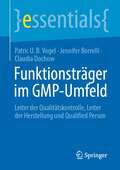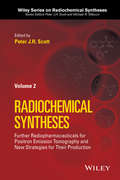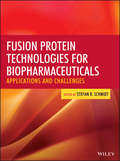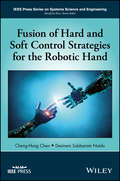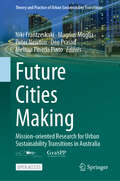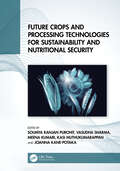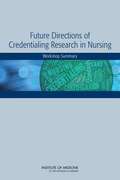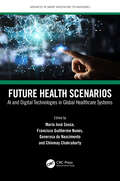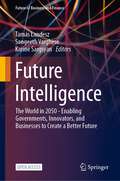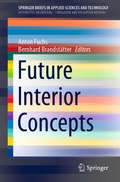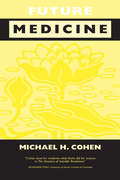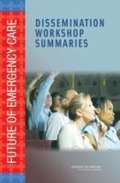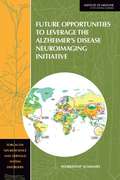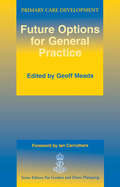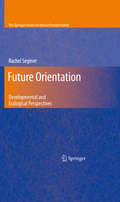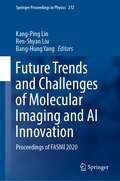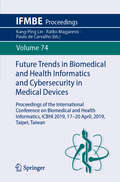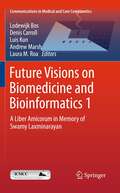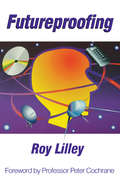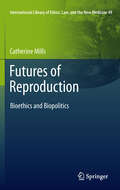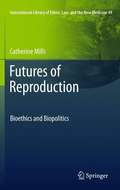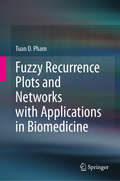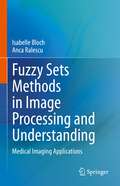- Table View
- List View
Funktionsträger im GMP-Umfeld: Leiter der Qualitätskontrolle, Leiter der Herstellung und Qualified Person (essentials)
by Patric U. Vogel Jennifer Borrelli Claudia DochowPer Gesetz und Verordnung müssen pharmazeutische Unternehmen diverse sog. „Funktionsträger“ benennen und beschäftigen. Hierzu zählen u.a. der Leiter der Qualitätskontrolle, der Leiter der Herstellung und die Sachkundige Person, die auch als Qualified Person bezeichnet wird. Diese Funktionsträger erfüllen wichtige Aufgaben im GMP-Umfeld, die u.a. dazu dienen, die Produktqualität von Arzneimitteln und damit die Patientensicherheit zu gewährleisten. Diese Funktionsträger sind zentraler Dreh- und Angelpunkt aller Aktivitäten, die zur Erfüllung der GMP-Anforderungen bei der Herstellung und Prüfung erfolgen.
Further Radiopharmaceuticals for Positron Emission Tomography and New Strategies for Their Production: Further Radiopharmaceuticals For Positron Emission Tomography And New Strategies For Their Production (Wiley Series on Radiochemical Syntheses #1)
by Michael R. KilbournThis book describes methods and procedures for preparing PET radiopharmaceuticals, and highlights new methods for conducting radiochemical reactions with carbon-11 (C11) and fluorine-18 (F18), which are two of the most commonly used radionuclides in positron emission tomography (PET) imaging. • Provides reliable methods for radiochemical syntheses and reactions, including all essential information to duplicate the procedure • Eliminates the time-consuming process of searching journal articles and extracting pertinent details from lengthy experimental sections or supporting information • Focuses on an emerging and important area for pharmaceutical and medical applications • Encompasses technical, regulatory, and application aspects • Includes solid-phase radiochemistry, transition-metal catalyzed radiochemistry, microfluidics, click chemistry, green radiochemistry and new strategies for radiopharmaceutical quality control
Fusion Protein Technologies for Biopharmaceuticals: Applications and Challenges
by Stefan R. SchmidtThe state of the art in biopharmaceutical FUSION PROTEIN DESIGN Fusion proteins belong to the most lucrative biotech drugs—with Enbrel® being one of the best-selling biologics worldwide. Enbrel® represents a milestone of modern therapies just as Humulin®, the first therapeutic recombinant protein for human use, approved by the FDA in 1982 and Orthoclone® the first monoclonal antibody reaching the market in 1986. These first generation molecules were soon followed by a plethora of recombinant copies of natural human proteins, and in 1998, the first de novo designed fusion protein was launched. Fusion Protein Technologies for Biopharmaceuticals examines the state of the art in developing fusion proteins for biopharmaceuticals, shedding light on the immense potential inherent in fusion protein design and functionality. A wide pantheon of international scientists and researchers deliver a comprehensive and complete overview of therapeutic fusion proteins, combining the success stories of marketed drugs with the dynamic preclinical and clinical research into novel drugs designed for as yet unmet medical needs. The book covers the major types of fusion proteins—receptor-traps, immunotoxins, Fc-fusions and peptibodies—while also detailing the approaches for developing, delivering, and improving the stability of fusion proteins. The main body of the book contains three large sections that address issues key to this specialty: strategies for extending the plasma half life, the design of toxic proteins, and utilizing fusion proteins for ultra specific targeting. The book concludes with novel concepts in this field, including examples of highly relevant multifunctional antibodies. Detailing the innovative science, commercial realities, and brilliant potential of fusion protein therapeutics, Fusion Protein Technologies for Biopharmaceuticals is a must for pharmaceutical scientists, biochemists, medicinal chemists, molecular biologists, pharmacologists, and genetic engineers interested in determining the shape of innovation in the world of biopharmaceuticals.
Fusion of Hard and Soft Control Strategies for the Robotic Hand
by Cheng-Hung Chen Desineni Subbaram NaiduAn in-depth review of hybrid control techniques for smart prosthetic hand technology by two of the world’s pioneering experts in the field Long considered the stuff of science fiction, a prosthetic hand capable of fully replicating all of that appendage’s various functions is closer to becoming reality than ever before. This book provides a comprehensive report on exciting recent developments in hybrid control techniques—one of the most crucial hurdles to be overcome in creating smart prosthetic hands. Coauthored by two of the world’s foremost pioneering experts in the field, Fusion of Hard and Soft Control Strategies for Robotic Hand treats robotic hands for multiple applications. Itbegins withan overview of advances in main control techniques that have been made over the past decade before addressing the military context for affordable robotic hand technology with tactile and/or proprioceptive feedback for hand amputees. Kinematics, homogeneous transformations, inverse and differential kinematics, trajectory planning, and dynamic models of two-link thumb and three-link index finger are discussed in detail. The remainder of the book is devoted to the most promising soft computing techniques, particle swarm optimization techniques, and strategies combining hard and soft controls. In addition, the book: Includes a report on exciting new developments in prosthetic/robotic hand technology, with an emphasis on the fusion of hard and soft control strategies Covers both prosthetic and non-prosthetic hand designs for everything from routine human operations, robotic surgery, and repair and maintenance, to hazardous materials handling, space applications, explosives disposal, and more Provides a comprehensive overview of five-fingered robotic hand technology kinematics, dynamics, and control Features detailed coverage of important recent developments in neuroprosthetics Fusion of Hard and Soft Control Strategies for Robotic Hand is a must-read for researchers in control engineering, robotic engineering, biomedical sciences and engineering, and rehabilitation engineering.
Future Cities Making: Mission-oriented Research for Urban Sustainability Transitions in Australia (Theory and Practice of Urban Sustainability Transitions)
by Niki Frantzeskaki Peter Newton Deo Prasad Magnus Moglia Melissa Pineda PintoThis open access book describes the complex dynamics that coevolve in cities and from cities, to inform agendas for urban research and urban policy with a view to future city missions. It provides a suite of research-informed chapters on urban pathways that are early signals and visions for how future cities can be shaped and transformed as well as chapters from policy, industry and intermediary organization actors that relate and respond to these pathways from a mainstreaming and implementation perspective. This edited collection intends to trigger and capture an ambitious transformative agenda amongst researchers and practitioners who have as their mission to shape urban futures. While there is proliferating literature on cities, urbanism and urban governance, this book offers a unique selling point – implying a research positioning point – to the field of sustainability transitions by intersecting research on urban sustainability transitions and missions-oriented research. The focus on the nexus of game-changers, pathways and innovations sets the book firmly in the leading edge of urban transitions research. The book engages with a breadth of disciplines including sustainability science, urban planning, urban design, mobility, energy, climate change science, urban ecology, urban sociology, architecture, data science, sustainability transitions studies, policy analysis and policy studies, as well as environmental governance. As an output, it aims to engage with and inspire future research and teaching/education in the fields of architecture and urban planning, urban design, environmental governance, sustainability science, innovation studies and urban sociology.
Future Crops and Processing Technologies for Sustainability and Nutritional Security
by Vasudha Sharma Soumya Ranjan Purohit Meena Kumari Kasi Muthukumarappan Joanna Kane-PotakaOur current food system faces challenges across the board – from ensuring food security and reducing environmental impact to managing costs and minimizing waste. Fortunately, cutting-edge food processing technologies play a critical role in paving the way for a more sustainable future. Taking a two-track approach, Future Crops and Processing Technologies for Sustainability and Nutritional Security presents sustainable technologies and emerging crops that are capable of ensuring nutritional security. There are various crops that are nutritious but under-utilized. Crops covered in the book are those that are climate resilient and exhibit less use of water and zero discharge to environment, such as millets and legumes like chickpea, groundnuts, and pigeon pea.KEY FEATURES: Provides a comprehensive literature review on the opportunities and challenges in achieving sustainability and nutritional security Presents compatible, relevant crops to address both sustainability and nutritional security Discusses the emerging technologies/crops/food products to justify sustainability and potential to ensure nutritional security This book also provides information on all aspects related to the processing and use of sustainable technologies and crops. The use of technologies like 3D printing, novel drying method, high pressure processing, high-voltage treatments, and the proper combination of conventional methods are addressed.
Future Directions in Surrogacy Law: Law and Policy Reform in the UK and Beyond (Law, Society, Policy)
by Kirsty Horsey, Zaina Mahmoud and Katherine WadeThis edited collection brings together a range of experts on surrogacy, at a time when the law in the UK has been fully reconsidered for the first time in generations. Society has developed significantly since surrogacy laws were first written and the existing law is out of date and no longer fit for purpose. Each chapter in this collection considers one aspect of surrogacy regulation and analyses the potential effectiveness of proposed reforms or suggests what changes should be made based on experience in other jurisdictions. This is an unprecedented contribution to the public and regulatory debate on surrogacy.
Future Directions of Credentialing Research in Nursing: Workshop Summary
by Margaret A. MccoyThe nurse workforce constitutes the largest sector of health professionals in the United States and includes individuals with varying educational backgrounds and expertise. Like other health professions, nursing includes a large number of specialties and subspecialties. Nurses may seek certification, based on various standards and criteria, from a wide range of organizations. Similarly, organizations may participate in nursing credentialing programs, which typically reflect the attainment of various nursing care standards and outcome measures. It is, however, unclear how this additional training and education affects health care quality and patient health. "Future Directions of Credentialing Research in Nursing" examines short- and long-term strategies to advance research on nurse certification and organizational credentialing. This report summarizes a workshop convened by the Institute of Medicine in September 2014 to examine a new framework and research priorities to guide future research on the impact of nurse credentialing and certification on outcomes for nurses, organizations, and patients. Over 100 people attended the workshop, which focused on topics such as emergent priorities for research in nursing credentialing; critical knowledge gaps and methodological limitations in the field; promising developments in research methodologies, health metrics, and data infrastructures to better evaluate the impact of nursing credentialing; and short- and long-term strategies to encourage continued activity in nursing credentialing research. "Future Directions of Credentialing Research in Nursing" is a record of the presentations, discussion, and break-out sessions of this event.
Future Forsaken: Abuses Against Children Affected by HIV/AIDS in India
by Human Rights WatchThis 209-page report documents how many doctors refuse to treat or even touch HIV-positive children. Some schools expel or segregate children because they or their parents are HIV-positive. Many orphanages and other residential institutions reject HIV-positive children or deny that they house them. Children from families affected by AIDS may be denied an education, pushed onto the street, forced into the worst forms of child labor, or otherwise exploited, all of which puts them at greater risk of contracting HIV.
Future Health Scenarios: AI and Digital Technologies in Global Healthcare Systems (Advances in Smart Healthcare Technologies)
by Chinmay Chakraborty Maria José Sousa Francisco Guilherme Nunes Generosa Do NascimentoDigital technologies is a major emerging area to invest and research in new models of health management. Future health scenarios are constituted by technologies in health and clinical decision-making systems. This book provides a unique multidisciplinary approach for exploring the potential contribution of AI and digital technologies in enabling global healthcare systems to respond to urgent twenty-first-century challenges. Deep analysis has been made regarding telemedicine using big data, deep learning, robotics, mobile and remote applications. Features: Focuses on prospective scenarios in health to predict possible futures. Addresses the urgent needs of the key population, socio-technical and health themes. Covers health innovative practices as 3D models for surgeries, big data to treat rare diseases, and AI robot for heart treatments. Explores telemedicine using big data, deep learning, robotics, mobile and remote applications. Reviews public health based on predictive analytics and disease trends. This book is aimed at researchers, professionals, and graduate students in computer science, artificial intelligence, decision support, healthcare technology management, biomedical engineering, and robotics.
Future Intelligence: The World in 2050 - Enabling Governments, Innovators, and Businesses to Create a Better Future (Future of Business and Finance)
by Karine Sargsyan Tamás Landesz Sangeeth VargheseThe first quarter of the 21st century introduced the world to rapid uncertainty, be it the social-political and financial crises, or pandemics, or the shaking up of well-established democracies with an increasing rise in populism. At the same time, the technological promise has taken off with automation, artificial intelligence, and nanotechnologies increasingly becoming an economic reality. This open-access book brings together experts of specific domains, through the windows of their experience, and in a crowdsourced fashion, to analyze these world developments to develop an overall view, a compelling case of what we should be prepared for, as we march towards 2050. Topics covered include the future of leadership, the future of solving global challenges, and designing a way of life in harmony with nature. Other topics include disruptive entrepreneurship, the relevance of geographical borders, game-changing future innovations, education, and networked learning, interplanetary travel, and communication. The book also places an importance on the role of empathy, mindfulness, presence, and sharing becoming the anchors for future decision-making by 2050. Of general interest to anyone eager to understand the future of the world, this book is particularly useful for planners, policymakers, strategists and entrepreneurs.
Future Interior Concepts (SpringerBriefs in Applied Sciences and Technology)
by Anton Fuchs Bernhard BrandstätterIn this book, the authors highlight multiple aspects of and views on comprehensive automotive interior comfort for future mobility. In this context, passenger comfort comprises thermal, acoustic, seat perception, as well as human–machine interaction in the passenger cabin. In five chapters, the contributing authors, hailing from universities, research centers and industry, share their expertise and insights. They take a closer look at future interior concepts from the standpoints of fundamental and applied research, as well as practical aspects.
Future Medicine: Ethical Dilemmas, Regulatory Challenges, and Therapeutic Pathways to Health Care and Healing in Human Transformation
by Michael H. CohenFuture Medicineis an investigation into the clinical, legal, ethical, and regulatory changes occurring in our health care system as a result of the developing field of Complimentary and Alternative Medicine (CAM). Here Michael H. Cohen describes the likely evolution of the legal system and the health care system at the crossroads of developments in the way human beings care for body, mind, emotions, environment, and soul. Through the use of fascinating and relevant case studies, Cohen presents stimulating questions that will challenge academics, intellectuals, and all those interested in the future of health care. In concise, evocative strokes, the book lays the foundation for a novel synthesis of ideas from such diverse disciplines as transpersonal psychology, political philosophy, and bioethics. Providing an exploration of regulatory conundrums faced by many healing professionals, Cohen articulates the value of expanding our concept of health care regulation to consider not only goals of fraud control and quality assurance, but also health care freedom, integration of global medicine, and human transformation. Future Medicineprovides a fair-minded, illuminating, and honest discussion that will interest hospice workers, pastoral counselors, and psychotherapists, as well as bioethicists, physicians and allied health care providers, complementary and alternative medical providers (such as chiropractors, acupuncturists, naturopaths, massage therapists, homeopaths, and herbalists), and attorneys, hospital administrators, health care executives, and government health care workers. Michael H. Cohen is Director for Legal Programs, the Center for Research and Education in Complementary and Integrative Medical Therapies, Beth Israel Deaconess Medical Center, Harvard Medical School.
Future Of Emergency Care: Dissemination Workshop Summaries
by Institute of Medicine of the National AcademiesThe National Academies Press (NAP)--publisher for the National Academies--publishes more than 200 books a year offering the most authoritative views, definitive information, and groundbreaking recommendations on a wide range of topics in science, engineering, and health. Our books are unique in that they are authored by the nation's leading experts in every scientific field.
Future Opportunities to Leverage the Alzheimer's Disease Neuroimaging Initiative: Workshop Summary
by Institute of Medicine of the National AcademiesNearly 5.3 million Americans are living with Alzheimer's disease, and 26.6 million people are affected worldwide. The Alzheimer's Disease Neuroimaging Initiative (ADNI), a public-private partnership, provides a publicly available, international database of clinical and imaging data to foster research and collaboration on Alzheimer's research worldwide. The Institute of Medicine held a workshop on July 12, 2010, to explore opportunities to use information from and partnerships formed because of ADNI to continue to improve the understanding and treatment of Alzheimer's disease.
Future Options for General Practice
by Geoff Meads Ian CarruthersWith the advent of the new health authorities, multifunds and consortia, it is likely that the GP's professional leadership of primary care will rapidly become only one of a number of provider options. This book defines some of the future options for the organization of primary care. The evolving possible roles of GPs and practices in these changing circumstances are examined closely. As the new health authorities come into full legislative force, how will they deploy the combined financial allocations for primary and secondary care to support their new capacity to enter into local contracts? Which health care providers will emerge in this market place in response to this shift in commissioning power? These are critical questions for general practice. With contributions from a variety of sources that reflect the varied origins of organizational initiatives, this is a book for planners, providers and purchasers of extended primary care.
Future Orientation
by Rachel SeginerWhere am I going? What do I want to do with my life? Such questions are typical of--even essential to--adolescence and continue to influence individuals throughout their lifetimes. And although human beings are capable of anticipating future events even as infants, the teen years are the peak period for weighing options and setting long-range goals. Future Orientation: Development and Ecological Perspectives synthesizes a wealth of theory and empirical data to explore future thinking as both a developmental process and an individual one. Starting with its origins in childhood, the book identifies the forces that affect this evolution, from early interactions with parents to personality traits and self-processes. Adolescents' future orientation is analyzed by its influences--a complex network of gender expectations, family and peer relationships, and cultural variables--and is, in turn, linked to developmental outcomes at school, capacity for intimacy, and adjustment in emerging adulthood and in adult life. This unique volume: Examines future orientation as an aspect of positive psychology, focusing on the stages of preadolescence, adolescence, and emerging adulthood. Relates future orientation with other psychological constructs relevant to this age group, including identity and self-esteem. Offers ecological and developmental perspectives to explore the effects of family members and peer groups on future thinking. Compares adolescent future thinking across cultures and discusses the roles of gender and gender constructs in future orientation. Complements developmental and educational psychology as well as counseling and parental guidance courses. Given the current climate of rapid social change, Future Orientation is an invaluable reading for researchers, clinicians, and practitioners, including child and school psychologists, psychiatrists, counselors, social workers, and others who work with young people during this critical juncture.
Future Trends and Challenges of Molecular Imaging and AI Innovation: Proceedings of FASMI 2020 (Springer Proceedings in Physics #272)
by Kang-Ping Lin Ren-Shyan Liu Bang-Hung YangThis volumes presents the proceedings of the FASMI 2020 conference, held at Taipei Veterans General Hospital on November 20-22, 2020. It presents contributions on all aspects of molecular imaging, discovered by leading academic scientists and researchers. It also provides a premier interdisciplinary treatment of recent innovations, trend, and concerns as well as practical challenges and solutions in Molecular Imaging and put an emphasis on Artificial Intelligence applied to Imaging Data. FASMI is the annual meeting of the Federation of Asian Societies for Molecular Imaging
Future Trends in Biomedical and Health Informatics and Cybersecurity in Medical Devices: Proceedings of the International Conference on Biomedical and Health Informatics, ICBHI 2019, 17-20 April 2019, Taipei, Taiwan (IFMBE Proceedings #74)
by Paulo De Carvalho Ratko Magjarevic Kang-Ping LinThis book gathers the proceedings of the IV International Conference on Biomedical and Health Informatics (ICBHI 2019), held on 17-20 April, 2019, in Taipei, Taiwan. Contributions span a range of topics, including medical imaging, biosignal processing, biodata management and analytics, public and personalized health systems, mobile health applications and many more. The IV conference edition gave a special emphasis to cybersecurity issues and cutting-edge medical devices, as it is reflected in this book, which provides academics and professionals with extensive knowledge on and a timely snapshot of cutting-edge research and developments in the field of biomedical and health informatics.
Future Visions on Biomedicine and Bioinformatics 2
by Luis Kun Laura M. Roa Denis Carroll Lodewijk Bos Andrew MarshSwamy Laxminarayan was an outstanding researcher active in many diverse fields of science and technology. He was one of the most prominent biomedical scientists and his ideas influenced the Biomedical Technology substantially. This book tries to provide an overview on the multiple achievements of Swamy Laxminarayan. It presents a collection of his most outstanding publications and an overview on his outstanding life. This Volume is the second part of the liber amicorum in Memory of Swamy Laxminarayan.
Futureproofing: If You Can Imagine it, it Will Happen, If You Can't - You're Out of it
by Roy Lilley Peter CochraneIf you can imagine it it will happen...if you can't you're out of it! This book is a white-knuckle ride. It drills down into what we are doing now and comes up in the future to see what comes next. The book is a commentary and a clarion call and an invitation to see round corners and a clarion call to respond to what's there. Roy Lilley has been speaking on Futureproofing around the world throughout the 'nineties. His aim has been to awaken managers entrepreneurs and anyone who will listen to the fact that the world is changing. Faster and faster like a spiral fundamentally and structurally leaving behand those who are unprepared. Thousands of people are now meeting the challenges Futureproofing presents. You decide - keep up or give up. If you have heard Roy Lilley speak on Futureproofing you will want this book ...if you have not yet heard him read it first.
Futures of Reproduction
by Catherine MillsIssues in reproductive ethics, such as the capacity of parents to 'choose children', present challenges to philosophical ideas of freedom, responsibility and harm. This book responds to these challenges by proposing a new framework for thinking about the ethics of reproduction that emphasizes the ways that social norms affect decisions about who is born. The book provides clear and thorough discussions of some of the dominant problems in reproductive ethics - human enhancement and the notion of the normal, reproductive liberty and procreative beneficence, the principle of harm and discrimination against disability - while also proposing new ways of addressing these. The author draws upon the work of Michel Foucault, especially his discussions of biopolitics and norms, and later work on ethics, alongside feminist theorists of embodiment to argue for a new bioethics that is responsive to social norms, human vulnerability and the relational context of freedom and responsibility. This is done through compelling discussions of new technologies and practices, including the debate on liberal eugenics and human enhancement, the deliberate selection of disabilities, PGD and obstetric ultrasound.
Futures of Reproduction: Bioethics and Biopolitics
by Catherine MillsIssues in reproductive ethics, such as the capacity of parents to 'choose children', present challenges to philosophical ideas of freedom, responsibility and harm. This book responds to these challenges by proposing a new framework for thinking about the ethics of reproduction that emphasizes the ways that social norms affect decisions about who is born. The book provides clear and thorough discussions of some of the dominant problems in reproductive ethics - human enhancement and the notion of the normal, reproductive liberty and procreative beneficence, the principle of harm and discrimination against disability - while also proposing new ways of addressing these. The author draws upon the work of Michel Foucault, especially his discussions of biopolitics and norms, and later work on ethics, alongside feminist theorists of embodiment to argue for a new bioethics that is responsive to social norms, human vulnerability and the relational context of freedom and responsibility. This is done through compelling discussions of new technologies and practices, including the debate on liberal eugenics and human enhancement, the deliberate selection of disabilities, PGD and obstetric ultrasound.
Fuzzy Recurrence Plots and Networks with Applications in Biomedicine
by Tuan D. PhamThis book presents an original combination of three well-known methodological approaches for nonlinear data analysis: recurrence, networks, and fuzzy logic.After basic concepts of these three approaches are introduced, this book presents recently developed methods known as fuzzy recurrence plots and fuzzy recurrence networks. Computer programs written in MATLAB, which implement the basic algorithms, are included to facilitate the understanding of the developed ideas. Several applications of these techniques to biomedical problems, ranging from cancer and neurodegenerative disease to depression, are illustrated to show the potential of fuzzy recurrence methods. This book opens a new door to theorists in complex systems science as well as specialists in medicine, biology, engineering, physics, computer science, geosciences, and social economics to address issues in experimental nonlinear signal and data processing.
Fuzzy Sets Methods in Image Processing and Understanding: Medical Imaging Applications
by Isabelle Bloch Anca RalescuThis book provides a thorough overview of recent methods using higher level information (object or scene level) for advanced tasks such as image understanding along with their applications to medical images. Advanced methods for fuzzy image processing and understanding are presented, including fuzzy spatial objects, geometry and topology, mathematical morphology, machine learning, verbal descriptions of image content, fusion, spatial relations, and structural representations. For each methodological aspect covered, illustrations from the medical imaging domain are provided. This is an ideal book for graduate students and researchers in the field of medical image processing.
